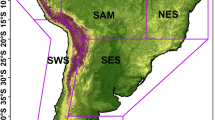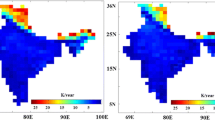Abstract
The release of new data constituting the Coupled Model Intercomparison Project—Phase 5 (CMIP5) database is an important event in both climate science and climate services issues. Although users’ eagerness for a fast transition from CMIP3 to CMIP5 is expected, this change implies some challenges for climate information providers. The main reason is that the two sets of experiments were performed in different ways regarding radiative forcing and hence continuity between both datasets is partially lost. The objective of this research is to evaluate a metric that is independent of the amount and the evolution of radiative forcing, hence facilitating comparison between the two sets for surface temperature over eastern North America. The link between CMIP3 and CMIP5 data sets is explored spatially and locally (using the ratio of local to global temperatures) through the use of regional warming patterns, a relationship between the grid-box and the global mean temperature change for a certain time frame. Here, we show that local to global ratios are effective tools in making climate change information between the two sets comparable. As a response to the global mean temperature change, both CMIP experiments show very similar warming patterns, trends, and climate change uncertainty for both winter and summer. Sensitivity of the models to radiative forcing is not assessed. Real inter-model differences remain the largest source of uncertainty when calculating warming patterns as well as spatially-based patterns for the pattern scaling approach. This relationship between the datasets, which may escape users when they are provided with a single radiative forcing pathway, needs to be stressed by climate information providers.





Similar content being viewed by others
References
Bitz C, Ridley J, Holland M (2012) Global climate models and 20th and 21st century arctic climate change. In: Lemke P, Jacobi H-W (eds) Arctic climate change—the ACSYS decade and beyond, p 405–436. doi:10.1007/978-94-007-2027-5_11
Clarke L, Edmonds J, Jacoby H, Pitcher H, Reilly J, Richels R (2007) Scenarios of Greenhouse Gas Emissions and Atmospheric Concentrations. Sub-report 2.1A of Synthesis and Assessment Product 2.1 by the U.S. Climate Change Science Program and the Subcommittee on Global Change Research. Department of Energy, Office of Biological & Environmental Research, Washington, 7 DC., USA, 154 pp
Fordham DA, Wigley TML, Brook BW (2011) Multi-model climate projections for biodiversity risk assessments. Ecol Appl 21(8):3317–3331. doi:10.1890/11-0314.1
Haine T, Böning C, Brandt P (2008) North Atlantic deep water formation in the Labrador Sea, recirculation through the subpolar gyre, and discharge to the subtropics. In: Dickson RR, Meincke J, Rhines P (eds) Arctic–subarctic
Hawkins E, Sutton RT (2009) The potential to narrow uncertainty in regional climate predictions. Bull Am Meteorol Soc 90(8):1095–1107. doi:10.1175/2009BAMS2607.1, ISSN 1520–0477
Houghton JT, Jenkins GJ, Ephraums JJ (eds) (1990) Climate change: the IPCC scientific assessment. Cambridge University Press, Cambridge, 365 pp
Hulme M, Wigley TML, Barrow EM, Raper SCB, Centella A, Smith SJ, Chipanshi AC (2000) Using a climate scenario generator for vulnerability and adaptation assessments: MAGICC and SCENGEN version 2.4 workbook. In: Lim B, Smith J (eds) Climatic Research Unit, Norwich, U.K., 52 pp
Mearns OL, Gutowski W, Jones R, Leung R, McGinnis S, Ana Nunes YQ (2009) A regional climate change assessment program for North America. Eos 90:2008–2009
Meehl GA, Stocker TF, Collins WD, Friedlingstein P, Gaye AT, Gregory JM, Kitoh A, Knutti R, Murphy JM, Noda A, Raper SCB, Watterson IG, Weaver AJ, Zhao Z-C (2007) Global climate projections. In: Solomon S, Qin D, Manning M, Chen Z, Marquis M, Averyt KB, Tignor M, Miller HL (eds) Climate change 2007: the physical science basis. Contribution of Working Group I to the Fourth Assessment Report of the Intergovernmental Panel on Climate Change. Cambridge University Press, Cambridge
Mitchell JFB, Johns TC, Eagles M, Ingram WJ, Davis RA (1999) Towards the construction of climate change scenarios. Clim Chang 41:547–581. doi:10.1023/A:1005466909820
Moss R, Babiker M, Brinkman S, Calvo E, Carter T, Edmonds J, Elgizouli I, Emori S, Erda L, Hibbard K, Jones R, Kainuma M, Kelleher J, Lamarque JF, Manning M, Matthews B, Meehl J, Meyer L, Mitchell J, Nakicenovic N, O’Neill B, Pichs R, Riahi K, Rose S, Runci P, Stouffer R, van Vuuren D, Weyant J, Wilbanks T, van Ypersele JP, Zurek M (2008) Towards new scenarios for analysis of emissions, climate change, impacts, and response strategies. Technical summary. Intergovernmental Panel on Climate Change, Geneva, 25 pp
Pennell C, Reichler T (2011) On the effective number of climate models. J Clim 24:2358–2367
Ruosteenoja K, Tuomenvirta H, Jylhä K (2007) GCM-based regional temperature and precipitation change estimates for Europe under four SRES scenarios applying a super-ensemble pattern-scaling method. Clim Chang 81:193–208. doi:10.1007/s10584-006-9222-3
Santer BD, Wigley TML, Schlesinger ME, Mitchell JFB (1990) Developing Climate Scenarios from Equilibrium GCM Results. Max-Planck-Institut für Meteorologie Report No. 47, Hamburg, Germany, 29 pp
Solomon S et al (2011) Climate stabilization targets: emissions, concentrations, and impacts over decades to millennia. The National Academic Press, Washington
van Vuuren DP, Edmonds J, Kainuma M, Riahi K, Thomson A, Hibbard K, Hurtt GC, Kram T, Krey V, Lamarque J-F, Masui T, Meinshausen M, Nakicenovic N, Smith SJ, Rose SK (2011) The representative concentration pathways: an overview. Clim Chang 5–31. doi:10.1007/s10584-011-0148-z
Acknowledgments
We thank the FRSCO program at Ouranos for allowing the first author to participate in this project. We wish to thank Dr. Marco Braun of Consortium Ouranos on his help in data processing. We acknowledge the World Climate Research Programme’s Working Group on Coupled Modelling, which is responsible for CMIP, and we thank the climate modeling groups (http://cmip-pcmdi.llnl.gov/cmip5/citation.html) for producing and making available their model output. Also, we would like to thank the three anonymous reviewers for their very substantial contributions toward improving our manuscript.
Author information
Authors and Affiliations
Corresponding author
Rights and permissions
About this article
Cite this article
Markovic, M., de Elía, R., Frigon, A. et al. A transition from CMIP3 to CMIP5 for climate information providers: the case of surface temperature over eastern North America. Climatic Change 120, 197–210 (2013). https://doi.org/10.1007/s10584-013-0782-8
Received:
Accepted:
Published:
Issue Date:
DOI: https://doi.org/10.1007/s10584-013-0782-8




